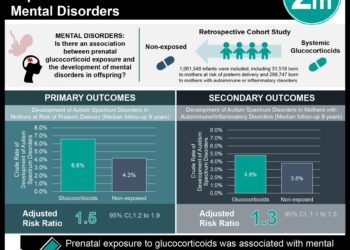Adolescent depression and suicide risk increased during the COVID-19 pandemic
1. In this large study of adolescent primary care visits in Philadelphia, the prevalence of positive screens for depressive symptoms and suicide risk increased during the pandemic when compared to pre-pandemic data.
2. Females were at significantly higher risk of screening positive both for moderate-to-severe depressive symptoms as well as for suicide risk.
Evidence Rating Level: 2 (Good)
Study Rundown: Social isolation and loneliness have increased as a result of school closures and social distancing during the COVID-19 pandemic, giving rise to increasing concerns about adolescent mental health. This large study of primary care visits occurring in semi-rural, suburban, and urban settings assessed changes in screening patterns and prevalence of depressive symptoms and suicide risk in adolescents aged 12-21 years. Overall, there was a small decrease in the percentage of well-visits. However, there was a significant increase in the prevalence of positive screens for mild-to-moderate depressive symptoms and for suicide risk, especially among female adolescents. This finding corroborates previous research that has suggested that female adolescents may already be at increased risk for depressive symptoms and suicide risk. A major strength of this study is its large sample size of adolescents across multiple settings and socioeconomic backgrounds. However, significant limitations include the exclusion of adolescents who do not attend primary care visits, and those who present directly to the emergency department. This study highlights the need for consistent screening for adolescent depression and suicide risk in the primary care setting. It may also be helpful to expand screening programs to schools and other community programs.
Click to read the study in PEDIATRICS
Relevant Reading: How is COVID-19 pandemic impacting mental health of children and adolescents?
In-Depth [cross-sectional study]: This cross-sectional study extracted data from the electronic health records of 91,188 adolescent well visits within 29 practices of the Children’s Hospital of Philadelphia (CHOP) primary care network. Approximately half of these visits occurred during the pre-pandemic period defined as June to December 2019, and half during the pandemic period defined as June to December 2020. Data included demographic information, the percent of adolescents screened for depression and suicide risk, and the percent of adolescents screening positive for either of these two items. Depression screening was conducted using the Patient Health Questionnaire-Modified for Teens (PHQ-9-M), and suicide risk was assessed using 3 targeted questions about suicide. The percentage of visits where screening was conducted slightly decreased from the pre-pandemic to the pandemic period (77.6% to 75.8%, prevalence ratio (PR): 0.98, 95% CI: 0.90-1.06). There was a 24% increase (PR: 1.24, 95% CI: 1.15, 1.34) in the prevalence of adolescents screening positive for moderate to severe depressive symptoms during the pandemic period. Increases in depressive symptoms were more pronounced among female, non-Hispanic White, non-Hispanic Black, and other race adolescents. There was also a 16% increase (PR: 1.16, 95% CI: 1.08, 1.26) in the prevalence of adolescents screening positive for suicide risk during the pandemic period. Increases in suicide risk were also significantly larger in females than in males.
Image: PD
©2021 2 Minute Medicine, Inc. All rights reserved. No works may be reproduced without expressed written consent from 2 Minute Medicine, Inc. Inquire about licensing here. No article should be construed as medical advice and is not intended as such by the authors or by 2 Minute Medicine, Inc.







